Services
According to the Medical Treatment Law, Medical Rehabilitation is a branch of medicine that deals with the development or recovery of a person’s physical, psychological, social, occupational and educational potential according to his physiological or anatomical limitations or, in the case of severe health problems, adapting the patient’s life to the environment and society.
The purpose of medical rehabilitation services is to reduce or eliminate restrictions for people with certain functional disorders, as well as to assess and reduce the risk of complications.
When receiving rehabilitation services in a day hospital, the patient is in the center like a daisy with specific goals to improve his quality of life, and around the petals is a rehabilitation team that helps the patient achieve these goals.
Successful medical rehabilitation is based on the patient who takes responsibility for his life and health, engages in his rehabilitation process, strives to achieve the set goals. In order for the rehabilitation process to be successful, the attending physician monitors the patient throughout the rehabilitation course, and the specialists involved in rehabilitation consult with each other in team meetings to evaluate the achieved results and change the rehabilitation plan according to the situation.
Physiotherapist
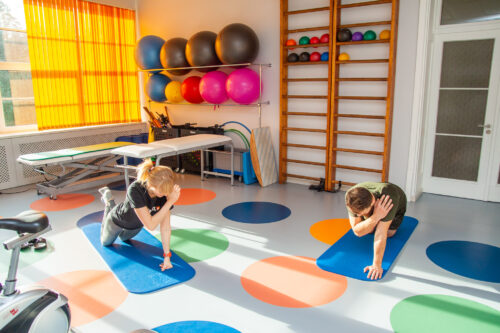
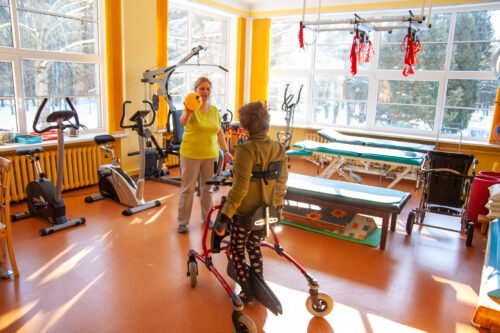
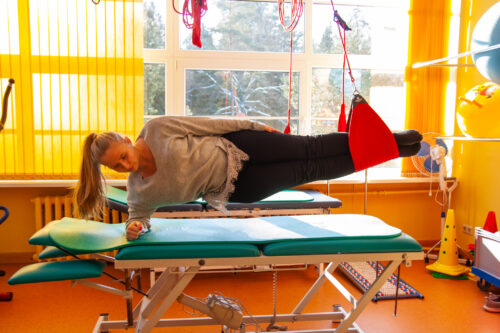
A physiotherapist is a medical practitioner who evaluates a person’s physical and functional condition, analyzes its impact on a person’s daily activities (including work) and the relationship with well-being. After careful examination and evaluation of the patient, therapeutic goals are set together with the patient (including, if necessary, relatives, such as guardian) and appropriate treatment methods acceptable to the patient are selected.
In order to assess the patient’s physical and functional condition, the physiotherapist uses various assessment methods in his work, such as:
- posture and course analysis;
- measurement and analysis of the volume and quality of movements;
- assessment of muscle functions (strength, length, endurance);
- balance and coordination tests;
- motor control analysis;
- assessment of body feelings and awareness;
- assessment of muscle and ligament tension;
- cardiovascular responses to exercise;
- assessment and analysis of respiratory function, as well as various special tests.
The main physiotherapeutic treatment methods are:
- therapeutic exercises – both active and passive exercises with the aim to improve muscle function, respiratory function and body sensation;
- balance and coordination training, relaxation techniques, positioning;
- mobilization of soft tissue techniques and joints;
- special therapies: Bobata therapy, PNF, etc., assistive device training and coaching, etc.
A physiotherapist can help:
- for various diseases of joints and muscles: for example, osteoarthritis of the joints, rheumatoid arthritis, various diseases of the spine, etc.;
- in the recovery phase after various injuries;
- in diseases and injuries of the nervous system: for example, the consequences of cerebrovascular disorders (strokes), the consequences of cerebral palsy, traumatic spinal cord and brain injuries, polyneuropathy, etc.;
- in diseases of the cardiovascular system: for example, in the recovery period after myocardial infarction and after various heart surgeries;
- respiratory diseases: for example, bronchial asthma, chronic bronchitis, etc.;
- in many other cases (health promotion, strengthening; health promotion of pregnant women and new mothers).
Successful physiotherapy prerequisite is an active patient participation in the treatment process.
Occupational therapist
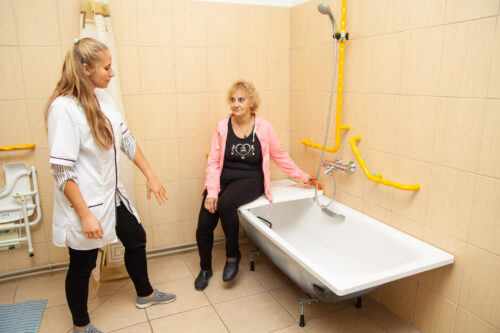
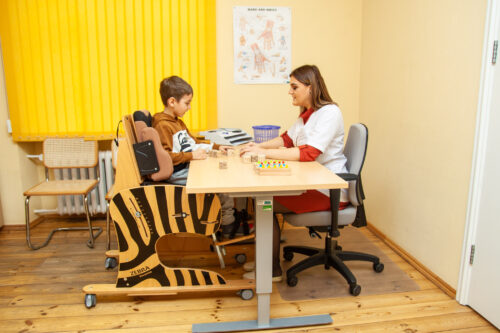
The main task of an occupational therapist is to help acquire/recover skills that allows the patient to be independent in daily activities.
People do various activities on a daily basis: eat, bathes, search for information on the Internet, visits family etc. Many of these people perform automatically without thinking about the conditions they provide. However, there may come a time when a person is unable to perform some (or perhaps all) of the usual activities due to illness or injury.
In work, occupational therapist uses activities that are important to the patient – their purpose is to hinder the progression of the disease, the development of disability and to promote the individual’s independence in daily activities. An occupational therapist helps a person to adapt to new conditions by reducing or eliminating environmental barriers. Occupational therapists train patients to use technical aids in daily activities and helps adapt them.
Persons can turn to an occupational therapist:
- with movement disorders;
- after a stroke;
- after head injuries;
- with fractures;
- peripheral nerve damage;
- after polytraumas;
- with rheumatological diseases;
- with burns;
- on the accessibility of the environment, the application of ergonomic principles in the work environment or during the daily activities of home life.
An occupational therapist also can help improve hand function in cases of limitation. Hand therapy is used for various hand diseases (inherited, acquired) or after injuries.
Speech and language therapist
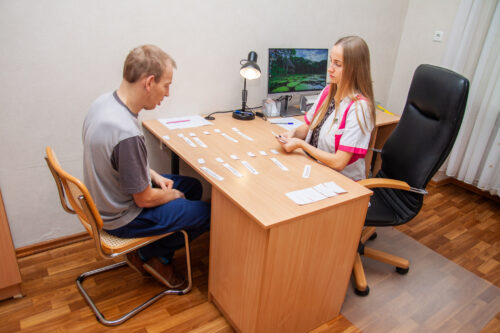
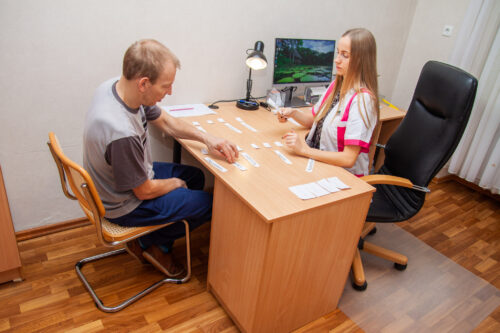
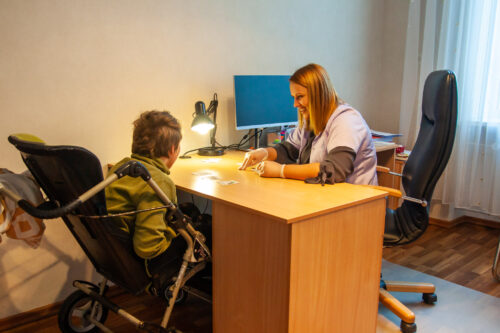
Speech and language therapist is certified medical person who performs assessment, diagnosis, correction and rehabilitation of communication, speech and language, phonation and swallowing disorders people of any age.
Speech and language therapist works with children and adults of different ages. The consultation for child with speech language therapist is necessary if any of the following symptoms are observed:
- problems with language development;
- difficulties with sound pronunciation;
- impairments of phonemic processes;
- language comprehension impairments;
- difficulties of reading and writing;
- voice disorders;
- stuttering/ speech rhythm disorders;
- difficulties of chewing and swallowing;
- problems of communication;
- hearing impairment.
weakness of articulation structures and disrupted physiologically correct breathing pattern (breathing through the mouth)
However, it is recommended to turn to a speech and language therapist even if you have any doubts about the child’s development, speech and language abilities according to age.
Adults, most often, come to the speech and language therapist after suffering of cerebrovascular accidents (stroke), head injuries, Parkinson’s disease, etc.
The consultation of speech language therapist in adults is necessary if any of the following symptoms are observed:
- communication, speech and language disorders;
- difficulties of swallowing;
- functional limitations of the articulation structures (restriction of tongue, lip movements etc.);
- head and neck paresis and paralysis;
- voice disorders.
During the first visit, speech and language therapist collects anamnesis about patient and performs an assessment. Based on the obtained data, the necessary therapy is developed, the goals and tasks of therapy are determined by specialist. Further treatment for each patient is individual and depends on the specific disorder. Therapy includes not only to train the patient and to perform the necessary exercises, but also to train the relatives and provide recommendations for work at home.
Massage
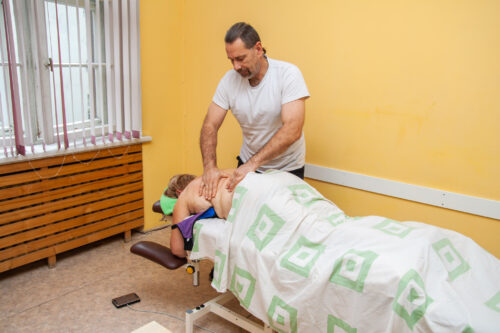
Massage is a tile tested value that stood the test of many centuries and has been able to evolve and improve. Massage has the most direct effect on skin and subcutaneous tissue. Today massage is used in various diagnostic diseases, cause, it has a positive effect on human health. Massage affects on the human body depending on the diagnosed disease – it relaxes or tones the muscles. Also, massage:
- improves metabolic processes;
- accelerates blood circulation and lymphatic drainage;
- relaxes the central nervous system;
- balances the sympathetic and parasympathetic nervous system.
During massage patients are relieved of tension and myofascial pain.
Nutritionist
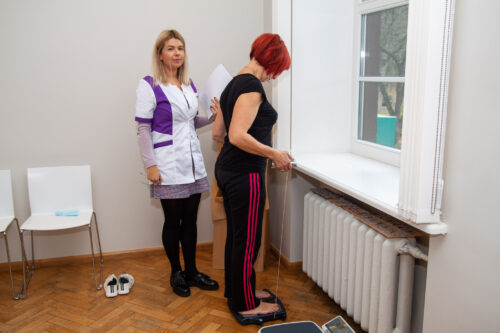
A nutritionist provides advice to help you become your best, healthiest version. By working with a nutritionist, you will be able to understand the impact of a balanced diet and a generally healthy lifestyle on your health. During the consultation, myths and prejudices about eating habits and unhealthy foods will be dispelled.
During the consultation, the nutritionist:
- specify information on the patient’s state of health, medical history, eating habits, level of physical activity and lifestyle;
- determine the anthropometric parameters of the body (weight, height, BMI);
- discuss with the patient’s daily menu to understand which eating habits do not comply with the basic principles of healthy eating;
- will help you learn ways to improve your daily diet according to your daily rhythm;
- will explain the basic principles of healthy eating, healthy cooking methods, weight control methods;
- will find an individual solution to each patient’s goals and wishes;
- will answer questions about healthy eating and healthy product selection in the store.
Psychologist
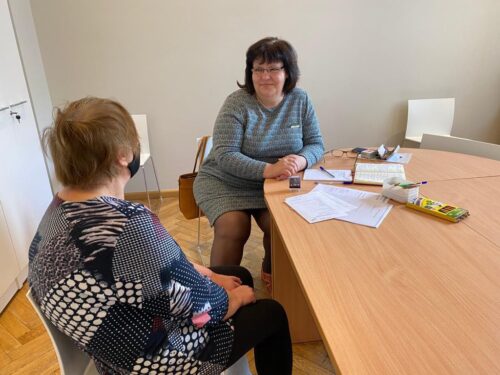
A psychologist is a specialist with a higher education in the science of psychology. The activity is regulated by the Law on Psychologists. A psychologist manages knowledge about human behavior patterns, ways of thinking, relationships with other people. The psychologist advises clients and helps them to understand difficulties, their causes and mechanisms, to look for new solutions, to be aware of their strengths and resources, to understand their life goals and desires. The psychologist and the client usually work together – set therapy goals, look for solutions; can help a person feel better, be stronger, and make better choices.
When working with clients psychologist:
- listens and tries to perceive the client’s point of view from his point of view without condemning;
- ready to talk about the client’s intentions, efforts, intentions;
- tries to understand the client’s thoughts, emotions and desires, including those that the client does not always manage to say;
- provides emotional support;
- helps the client to find resources within himself;
- helps to solve and make complex decisions;
- consults in the client’s language;
- provide the necessary information.
When working with clients, the psychologist respects the privacy of his clients and strictly adheres to the principles of confidentiality.
Visual Plastic Art Therapy

Visual Plastic Art Therapy is a type of art therapy that uses art and the creative process in a therapeutic context to enhance and promote a person’s mental, emotional and physical well-being.
In art therapy, a person is invited to represent his thoughts, feelings and needs – to draw, paint, create from clay or plasticine, to assemble as a collage from images or to find another more suitable form of artistic expression. Conversations are used in art therapy, but conversations “without words” can also take place.
In art therapy, both the creative process and the result of the work, reflections and also a conversation with the art therapist after the creative process are important. It is more related to everyone’s wishes and possibilities.
Music therapy
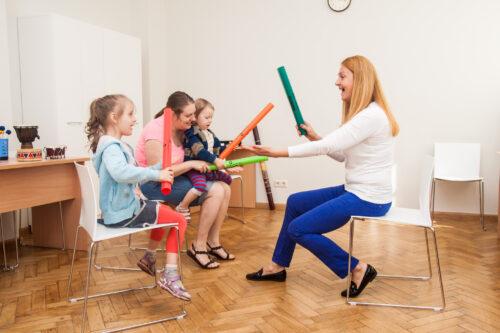
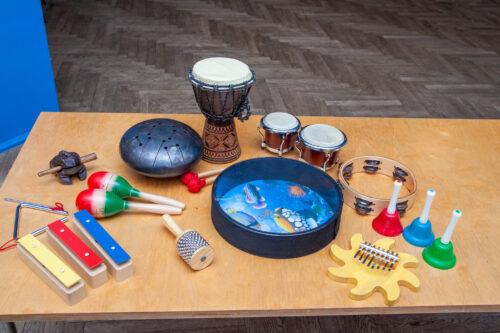
Music therapy is a field of healthcare in which music, is the manner of expression and the creative process are used for therapeutic purposes. It addresses and overcomes a person’s mental, emotional, social and physical health difficulties. Music can activate emotional and memory centers.
Music therapy is used for people of all ages and is done individually or in a group. Music therapy is recommended for patients with neurological (stroke), psychiatric, oncological, psychosomatic illnesses, physical injuries, hearing impaired, including after Cochlear implantation (hearing implant). Music therapy is also useful for practically healthy people who suffer from burnout, anxiety or other psycho-emotional difficulties, as well as it helps to gain new experiences, improves the quality of life, encourages to be spontaneous and creative.
Music therapy is divided into:
- Active (creative) music therapy – during this process, simple musical instruments, singing, vocalization are used with a therapist .
- Receptive music therapy – in this process is not only listening to music for relaxation purposes, but also to stimulate the imagination, solve difficulties.
No musical education is required to participate in the therapy process, you do not need to be able to play musical instruments.
Dance and movement therapy
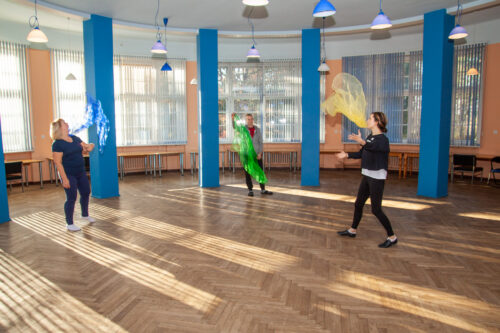
Dance and movement therapy is a field of health care that uses art – dance and movement – in its work to improve physical, emotional, cognitive (perception, memory, thinking, etc.) and social health.
The guideline of dance and movement therapy – the body and the psyche is an interacting system, which means that changes in the body and movements cause changes in the emotional state.
In the process of dance and movement therapy, in contrast to dance and physiotherapy, creative cooperation with the therapist, as well as reflection on this process, is important.
Dance and movement therapy will help you:
- understand and accept your emotional and physical condition;
- reduce depression, tension and anxiety, stabilize the sympathetic nervous system;
- to increase self-esteem, to promote a positive image of one’s body;
- to have fun;
- to develop and improve various qualities of movements – coordination, balance, etc.;
- to restore vitality, to come into contact with internal resources and creative potential;
- to develop social skills, improve communication skills and develop trust in relationships.
Physical therapy
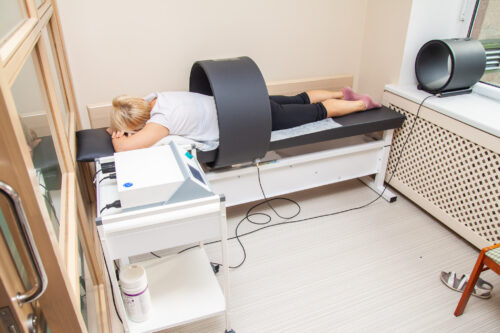
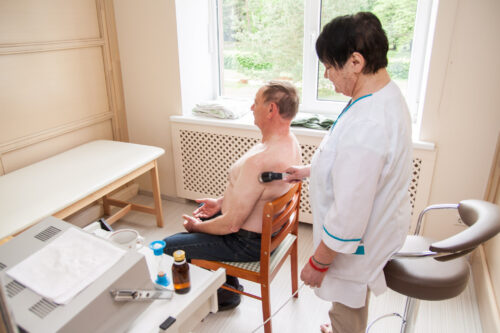
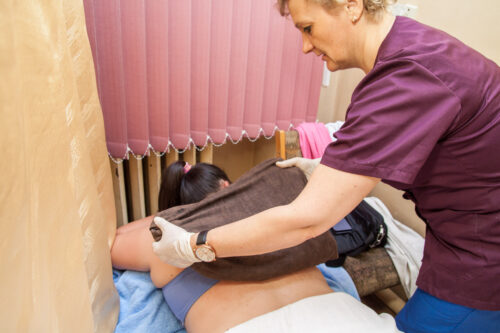
Physical therapy is a branch of medicine that uses a variety of artificial physical factors that occur in the environment, such as magnetic fields, ultraviolet radiation, and so on. They are considered to be physiological treatments that have a beneficial effect on the recovery process.
Physical therapy with other medical rehabilitation technologies is especially effective in the following cases:
- in cases of subacute and chronic inflammatory processes (tissues and organs);
- in case of traumatic injuries;
- in degenerative diseases of the joints and spine;
- in functional disorders of various organs and systems;
- in peripheral and central nervous system diseases, infections, injuries and occupational diseases;
- in case of peripheral vascular obliterative diseases.
With the help of physical therapy, patients can:
- reduce the possibility of complications, manifestations of unpleasant symptoms (such as pain);
- accelerate recovery time;
- reduce drug doses;
- to promote the supply (nutrients, oxygen) and excretion (slag, carbon dioxide) of substances in the body to the injured tissues or organs.
The following physical therapy services are available at the Rehabilitation Center “Tervete”:
- magnetic field therapy;
- drug phonophoresis;
- sinusoidally modulated current (SMC) therapy;
- microwave therapy;
- drug electrophoresis;
- light therapy (ultraviolet radiation therapy, bioptron lamp);
- laser therapy;
- sludge applications;
- aerosol therapy (inhalation, salt room);
- water healing (pearl bath, Baldoes mud bath, local baths, Sharko shower, underwater massage, circular shower).